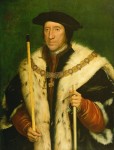 University of Leicester researchers have recreated the original tombs of Thomas Howard, 3rd Duke of Norfolk and Henry VIII’s illegitimate son, Henry Fitzroy, Duke of Richmond, later versions of which are now in St. Michael’s Church, in Framlingham, Suffolk. Using drawings in 16th century manuscripts, 3D laser scanning and 3D modeling, the team have recreated monuments that haven’t been seen in their original form since the Reformation of Henry VIII resulted in the destruction of the tombs’ original home: Thetford Priory.
University of Leicester researchers have recreated the original tombs of Thomas Howard, 3rd Duke of Norfolk and Henry VIII’s illegitimate son, Henry Fitzroy, Duke of Richmond, later versions of which are now in St. Michael’s Church, in Framlingham, Suffolk. Using drawings in 16th century manuscripts, 3D laser scanning and 3D modeling, the team have recreated monuments that haven’t been seen in their original form since the Reformation of Henry VIII resulted in the destruction of the tombs’ original home: Thetford Priory.
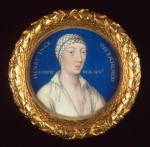 Henry Fitzroy, son of Henry VIII and his mistress Lady Elizabeth Blount, was married to the 3rd Duke of Norfolk’s daughter Mary when he died of consumption on July 23rd, 1536, at the age of 17. By his father’s command, he was discretely buried in a lead coffin in a secret ceremony at Thetford Priory. His father-in-law arranged for the construction of an elaborate monument to mark the burial and later commissioned the same for himself.
Henry Fitzroy, son of Henry VIII and his mistress Lady Elizabeth Blount, was married to the 3rd Duke of Norfolk’s daughter Mary when he died of consumption on July 23rd, 1536, at the age of 17. By his father’s command, he was discretely buried in a lead coffin in a secret ceremony at Thetford Priory. His father-in-law arranged for the construction of an elaborate monument to mark the burial and later commissioned the same for himself.
The two monuments were still being built in Thetford Priory, the Cluniac monastic house where several dukes of Norfolk and related people were buried, in 1540 when it was dissolved. One of the last monasteries to be hit by the Dissolution, after its demise Thetford Priory was given to Thomas Howard by King Henry. Howard planned to keep the building intact and use it as an extremely fancy family mausoleum.
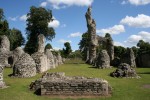 His plans were thwarted by his arrest for treason on December 12th, 1546. Thomas Howard was sent to the Tower. He was saved from execution by Henry VIII’s very conveniently timed death, but remained imprisoned in the Tower throughout the entire short reign of King Edward VI until finally being released and having his title and lands returned by Queen Mary in 1553. By then, Thetford Priory, which along with his other properties had been confiscated during Howard’s long imprisonment, was dilapidated and the Howard and Fitzroy tombs had been moved to St. Michael’s in Framlingham.
His plans were thwarted by his arrest for treason on December 12th, 1546. Thomas Howard was sent to the Tower. He was saved from execution by Henry VIII’s very conveniently timed death, but remained imprisoned in the Tower throughout the entire short reign of King Edward VI until finally being released and having his title and lands returned by Queen Mary in 1553. By then, Thetford Priory, which along with his other properties had been confiscated during Howard’s long imprisonment, was dilapidated and the Howard and Fitzroy tombs had been moved to St. Michael’s in Framlingham.
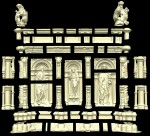 Thomas Howard and Henry FitzRoy’s original monuments were never finished. Parts of the structures were moved to Framlingham and integrated into new tombs built with different materials in a new style. Some pieces were left behind at Thetford where they would be rediscovered in archaeological excavations in the 19th and 20th centuries.
Thomas Howard and Henry FitzRoy’s original monuments were never finished. Parts of the structures were moved to Framlingham and integrated into new tombs built with different materials in a new style. Some pieces were left behind at Thetford where they would be rediscovered in archaeological excavations in the 19th and 20th centuries.
Dr Phillip Lindley, of the University of Leicester’s Department of the History of Art and Film, said: “Our exhibition studies the catastrophic effects of the Dissolution of Thetford Priory and of Henry VIII’s attempted destruction of Thomas Howard, third duke of Norfolk, on the ducal tomb-monuments at Thetford. […]
“With English Heritage’s help, we have managed to reunite the excavated pieces, which are scattered across various different museums and stores. It is wonderful that the British Museum have also loaned their two sculptures from the group.
“Using 3D laser scanning and 3D prints, we have — virtually — dismantled the monuments at Framlingham and recombined them with the parts left at Thetford in 1540, to try to reconstruct the monuments as they were first intended, in a mixture of the virtual and the real.”
Here’s the 3D rendering of Thomas Howard’s original tomb monument next to the final version now at Framlingham:
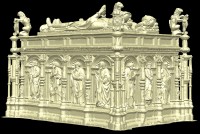
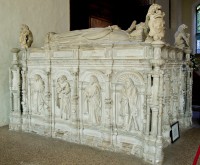
Both feature the twelve Apostles in shell niches along all four sides of the monument, a final flowering of Catholic motifs and aesthetics in an England that was saying goodbye to all that in a most wrenching, brutal manner. The saints are different, or at least in different places, but I don’t really see any other major changes.
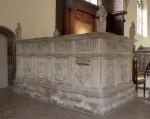 Unfortunately there are no pictures available of the 3D rendering of FitzRoy’s original monument. The final version in St. Michael’s today is the polar opposite of Howard’s in terms of its devotional motifs. It’s very secular, festooned with family heraldry which was particularly important to Henry as an illegitimate son.
Unfortunately there are no pictures available of the 3D rendering of FitzRoy’s original monument. The final version in St. Michael’s today is the polar opposite of Howard’s in terms of its devotional motifs. It’s very secular, festooned with family heraldry which was particularly important to Henry as an illegitimate son.
I had to look up ‘died of consumption’; I figured he perhaps drank or ate too much.. But it turns out it means he died of tuberculosis!
Yes indeedy. Or at least of some lung disease. Consumption was sort of a catch-all term for coughing to death, basically. Tuberculosis was the likeliest candidate because it was so widespread.
The third duke was one of the least attractive prominent figures at the court of Henry VIII, which is saying quite a bit.
All that cold mycobacterium miasma drifting through ancient castle stone and right up the noses and down the bronchi of our man Fitzroy. And Arthur, and Edward vi: and in different castles to boot. I want to snuggle all those cold little babies born down through the centuries doomed or sleeping. Then maybe again I dont! With the sweat, plague, syphilis, lack of medical knowledge/antibiotics/germs/nutrition, smallpox, measles, malaria, TB, and only God knows what else, even the puniest had to have been damn tough to survive. Mix it up with obsessively coveted pure royal bloodlines and I truly wonder how anyone did…
History is FABULOUS! :skull: